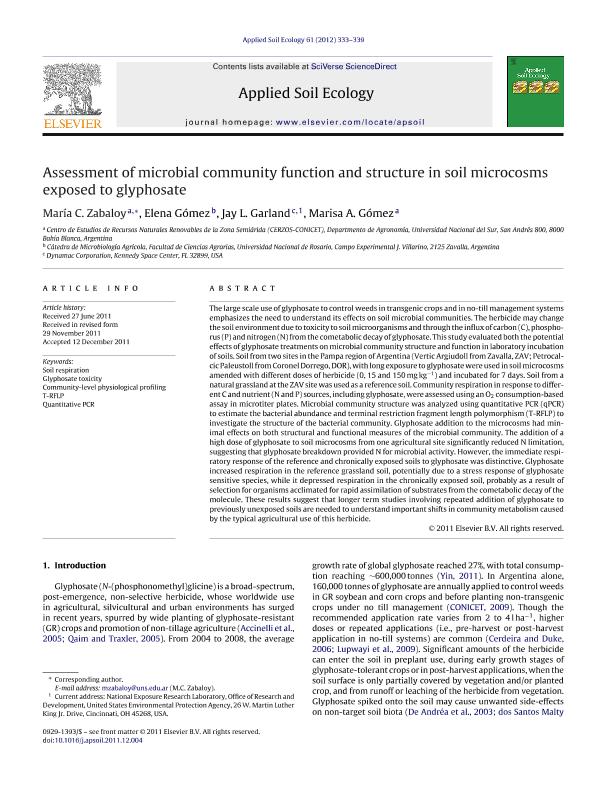Mostrar el registro sencillo del ítem
dc.contributor.author
Zabaloy, Maria Celina

dc.contributor.author
Gomez, Elena del Valle

dc.contributor.author
Garland, Jay L.
dc.contributor.author
Gomez, Marisa Anahi

dc.date.available
2019-05-16T20:31:37Z
dc.date.issued
2012-10
dc.identifier.citation
Zabaloy, Maria Celina; Gomez, Elena del Valle; Garland, Jay L.; Gomez, Marisa Anahi; Assessment of microbial community function and structure in soil microcosms exposed to glyphosate; Elsevier Science; Applied Soil Ecology; 61; 10-2012; 333-339
dc.identifier.issn
0929-1393
dc.identifier.uri
http://hdl.handle.net/11336/76596
dc.description.abstract
The large scale use of glyphosate to control weeds in transgenic crops and in no-till management systems emphasizes the need to understand its effects on soil microbial communities. The herbicide may change the soil environment due to toxicity to soil microorganisms and through the influx of carbon (C), phosphorus (P) and nitrogen (N) from the cometabolic decay of glyphosate. This study evaluated both the potential effects of glyphosate treatments on microbial community structure and function in laboratory incubation of soils. Soil from two sites in the Pampa region of Argentina (Vertic Argiudoll from Zavalla, ZAV; Petrocalcic Paleustoll from Coronel Dorrego, DOR), with long exposure to glyphosate were used in soil microcosms amended with different doses of herbicide (0, 15 and 150mgkg -1) and incubated for 7 days. Soil from a natural grassland at the ZAV site was used as a reference soil. Community respiration in response to different C and nutrient (N and P) sources, including glyphosate, were assessed using an O 2 consumption-based assay in microtiter plates. Microbial community structure was analyzed using quantitative PCR (qPCR) to estimate the bacterial abundance and terminal restriction fragment length polymorphism (T-RFLP) to investigate the structure of the bacterial community. Glyphosate addition to the microcosms had minimal effects on both structural and functional measures of the microbial community. The addition of a high dose of glyphosate to soil microcosms from one agricultural site significantly reduced N limitation, suggesting that glyphosate breakdown provided N for microbial activity. However, the immediate respiratory response of the reference and chronically exposed soils to glyphosate was distinctive. Glyphosate increased respiration in the reference grassland soil, potentially due to a stress response of glyphosate sensitive species, while it depressed respiration in the chronically exposed soil, probably as a result of selection for organisms acclimated for rapid assimilation of substrates from the cometabolic decay of the molecule. These results suggest that longer term studies involving repeated addition of glyphosate to previously unexposed soils are needed to understand important shifts in community metabolism caused by the typical agricultural use of this herbicide.
dc.format
application/pdf
dc.language.iso
eng
dc.publisher
Elsevier Science

dc.rights
info:eu-repo/semantics/openAccess
dc.rights.uri
https://creativecommons.org/licenses/by-nc-sa/2.5/ar/
dc.subject
Community-Level Physiological Profiling
dc.subject
Glyphosate Toxicity
dc.subject
Quantitative Pcr
dc.subject
Soil Respiration
dc.subject
T-Rflp
dc.subject.classification
Agricultura

dc.subject.classification
Agricultura, Silvicultura y Pesca

dc.subject.classification
CIENCIAS AGRÍCOLAS

dc.title
Assessment of microbial community function and structure in soil microcosms exposed to glyphosate
dc.type
info:eu-repo/semantics/article
dc.type
info:ar-repo/semantics/artículo
dc.type
info:eu-repo/semantics/publishedVersion
dc.date.updated
2019-05-14T17:42:09Z
dc.journal.volume
61
dc.journal.pagination
333-339
dc.journal.pais
Países Bajos

dc.journal.ciudad
Amsterdam
dc.description.fil
Fil: Zabaloy, Maria Celina. Consejo Nacional de Investigaciones Científicas y Técnicas. Centro Científico Tecnológico Conicet - Bahía Blanca. Centro de Recursos Naturales Renovables de la Zona Semiárida. Universidad Nacional del Sur. Centro de Recursos Naturales Renovables de la Zona Semiárida; Argentina
dc.description.fil
Fil: Gomez, Elena del Valle. Universidad Nacional de Rosario. Facultad de Ciencias Agrarias; Argentina
dc.description.fil
Fil: Garland, Jay L.. United States Environmental Protection Agency; Estados Unidos. Kennedy Space Center. Dynamac Corporation; Estados Unidos
dc.description.fil
Fil: Gomez, Marisa Anahi. Consejo Nacional de Investigaciones Científicas y Técnicas. Centro Científico Tecnológico Conicet - Bahía Blanca. Centro de Recursos Naturales Renovables de la Zona Semiárida. Universidad Nacional del Sur. Centro de Recursos Naturales Renovables de la Zona Semiárida; Argentina
dc.journal.title
Applied Soil Ecology

dc.relation.alternativeid
info:eu-repo/semantics/altIdentifier/url/http://www.sciencedirect.com/science/article/pii/S0929139311003258
dc.relation.alternativeid
info:eu-repo/semantics/altIdentifier/doi/http://dx.doi.org/10.1016/j.apsoil.2011.12.004
Archivos asociados
